
Business Management Solutions
Inclusive easy to use design!
(705) 849-6509
Lawn Weeds - Information
Below is an expanding list of lawn weeds that we have information about for our area!
Canada Thistle
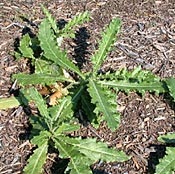
This is a perennial that reproduces by seed and rhizomes. Canada Thistle has an aggressive growth habit and forms dense patches. Leaves are smooth, green on the upper side of the leaf and on the bottom of the leaf it has spiny margins. Flowers are lavender and blooms from June to late fall.
Violets

There are two types of violets commonly found on lawns. They include field violets which is an annual weed and sweet violets which is a perennial weed. The violets reproduce by either seed or rootstalks. Their heart shaped leaves and their white, yellow or purple flowers distinguish them. Both types of violets are difficult to control.
Speedwell
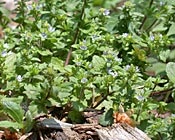
There are many types of Speedwell that can grow in your lawn. Some are annual that reproduce from seed and others are perennial that can reproduce by seed, rhizomes or creeping stems. The perennial plants are generally more difficult to control.
Spotted Spurge
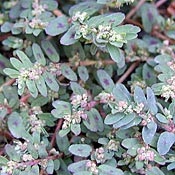
It is an annual and only reproduces by seed. Leaves vary in color from a reddish green to a dark green but usually have a purplish brown "splotch" near the middle of the leaf. Flowers are tiny, pinkish white and are hard to see. One way to identify spotted spurge is by breaking the stems or branches and a milk like liquid comes out.
Quackgrass
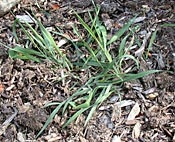
Cutworms are not worms, biologically speaking, but caterpillars; they are moth larvae that hide under litter or soil during the day, coming out in the dark to feed on plants. A larva typically attacks the first part of the plant it encounters, namely the stem, often of a seedling, and consequently cuts it down; hence the name cutworm.
Purslane

It is an annual and only reproduces by seed. The sprawling stems are thick, round, fleshy and are reddish brown in color. Leaves are bright green, wedge shaped, rubbery and thick. Purslane has tiny yellow flower with 5 petals and they seldom open unless the sun is shining. The cup shaped seedpods produce many small black seeds and these seeds may lie dormant in the soil for many years. It thrives in extremely hot, dry weather.
Oxalis
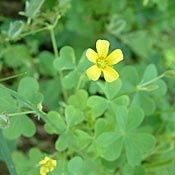
Oxalis is an upright perennial that only reproduces by seed. It has 3 pale green leaflets that are heart shaped and similar to clover. Flowers are small and have 5 yellow petals. As the flowers mature a cucumber shaped seedpod forms. When the seedpod is completely dry, the slightest touch will cause the seeds to be scattered over several feet.
Common Mallow
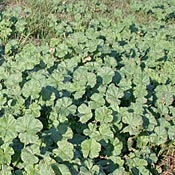
This plant can be perennial or biennial and only reproduces by seed. Mallow emerges from a taproot and sends out stems that trail along the ground but do not root at the nodes, like Ground Ivy. Leaves are kidney shaped and are found on long stems. Flowers are pinkish white and appear from June to late autumn.
Knotweed

It is an annual plant that reproduces only by seed. Stems form from a thin, tough, wiry, deep penetrating taproot. Tiny white flowers are not noticeable and are found between the leaf and stem. Knotweed prefers compacted soil usually along driveways, high traffic areas, football fields and more.
Ground Ivy
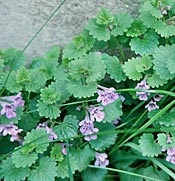
This perennial weed spreads and forms dense patches. The leaves appear opposite each other on square shaped stems and wherever they touch the ground, it takes root. It can also reproduce by seed as well as by the creeping stems. A distinguishing feature of this weed is that when you crush its stem or leaves it has a very strong mint-like odor. Flowers are purplish blue and are trumpet shaped.
Dandelion

This very hardy perennial has a strong taproot that can go down into the soil from 2 to 3 feet. The only way the dandelion reproduces is by seed. The large yellow blossoms mature into white puffballs full of seeds. These seeds can be carried many miles by the wind.
Crabgrass
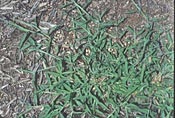
This is an annual that reproduces by seed. It germinates when soil temperatures stay above 59 F. Crabgrass germinates mid to late spring and is usually not visible until July or August. There are two types of crabgrass: Large and Smooth. Both types are yellow green in colour and have wide leaf blades that taper to a point at the end. Crabgrass produces purple seed heads when the plant matures. Flowers from July to September.
Clover

Clover is a perennial with creeping stems that root at the nodes. Clover is recognizable by its dark green color of its three leaflets with a white V mark in the center of each leaflet. The flowers can be white or pinkish in color and usually attracts bees. Clover can be a sign of low fertility. Clover is aggressive and can take over your lawn.
Buckhorn Plantain
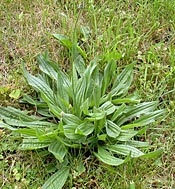
It is a perennial that only reproduces by seed. It has long narrow leaves with prominent parallel veins running the length of the leaf. Buckhorn has a taproot with strong lateral roots. Cutting or pulling the weed will only result in a new plant growing from any part of the root. Seed spikes are fairly small but several crops may be dropped into the soil during a season.
Black Medic
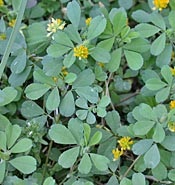
It is a dark green annual with spreading square stems which do not root at the nodes. The only way it reproduces is by seed. Black medic also has three leaflets and is often confused with clover but black medic does not have a white V mark in the center of each leaflet. Bright yellow flowers cluster and as each flower matures it forms a black seedpod containing a single seed.
Lawn Diseases - Information
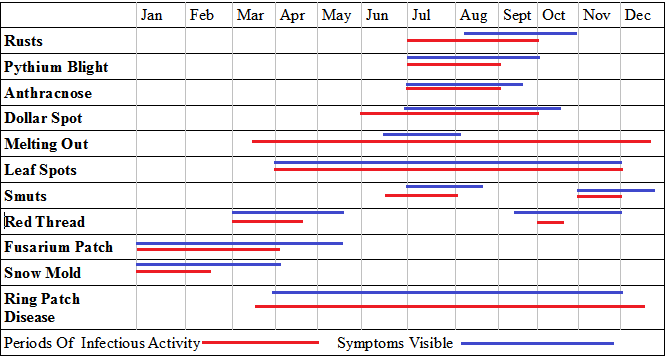
Fairy Rings

Occurs in early spring through late fall. Fairy Rings first appear as circles of dark green, lush, fast growing grass. A brown dead ring of grass surrounds the lush area. Several rings may appear in the same area. Rings or crescents commonly vary from 1 meter to 15 meters in diameter. They are caused by spores that become fungus that is contained within the soil and survives as mycelia or fungal roots. The mycelium can penetrate more than 30 cm (12") into the soil. It attacks a central point in your lawn and grows outward.
Grey or Pink Snow Mold
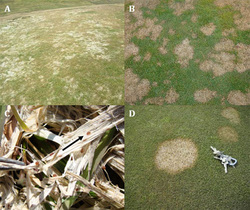
Snow Mould appears as a fluffy white, pink or grey residue that seems to follow the retreating snow line. Cool, wet conditions with or without snow cover cause this disease to flourish. A properly fertilized, well-maintained lawn is most resistant to damage from snow mold. Raking in early spring through the snow mold residue will help reduce this disease and quicken the healing process.
Smuts
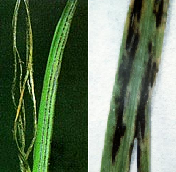
Occurs in spring and fall. Most turf grasses, particularly blue grasses and bent-grasses are susceptible. Cool conditions enhance fungal development and most of the infections occur in the spring and fall. Spring infections may have the greatest development and spore production before the summer and the infected plants may die in the hot dry weather. Fall infections may be less damaging in the same year but the fungus will over-winter and cause damage the following spring. Smuts plants are pale green and stunted, with narrow long streaks that start off yellow and turn black. As the spores are released from the black stripes, the leaves look shredded and then die.
Rusts

Occurs in late summer or fall affecting cool season grasses. Perennial Rye grass is the most susceptible and Kentucky Bluegrass is less susceptible. Rusts is most active during temperatures of 22-25C with a high humidity. Alternating weather patterns of cool and wet to hot and dry can also cause rusts. Rusts survive on the living and dead leaf tissue and in the thatch layer of turf grass or on alternate hosts (ornamental plants). Rusts appears as light yellow flecks on the leaves and sheaths, followed by reddish-brown colored spores. Rusts spores can be rubbed off easily, giving a reddish tinge to shoes and equipment. In most cases the rusts simply wilts the blades but in some extreme cases rusts can permanently damage your lawn.
Red Thread
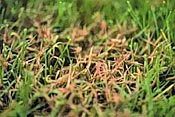
Occurs in cool, moist periods of spring and fall. It lives in soil, thatch and dead leaves all year round. Ragged patches of red to pink threads appear on the grass blade and sheath. Your lawn may appear from a distance to be suffering from lack of water. Red Thread looks like Leaf Spot and Dollar Spot. Some factors which may encourage the spread of the disease are poor air circulation, poor drainage and a thick thatch layer. It spreads throughout the lawn in the form of spores. Wind, air, water, animals and humans spread these spores. Red Thread attacks most types of grass but is generally found on lawns with low soil fertility that contains a high proportion of fescue and ryegrass.
Pythium
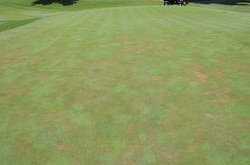
Occurs in the summer. Pythium is a fungal parasitic form of plant life. The fungi live in the soil thatch and dead leaves all year round and feed by drawing nutrients from the grass. During cooler parts of the season, they grow slowly and generally do not infect foliage. Some species cause roots to rot, during cool wet weather. When weather turns hot and humid, the fungi grow extremely rapidly causing infection and discoloration in a matter of hours. Outbreaks have been known to severely damage lawns in less then 24 hours. Early symptoms include small dark spots about 2" in diameter with a slimy or greasy texture and these spots can increase rapidly in size. During damp periods, such as early morning, the water soaked leaves collapse and become matted together by a fluffy white mass called mycelium. As the grass dries, the mycelium disappears and dead blades turn brown. Damaged areas will often appear as long streaks due to the spread of spores and mycelium.
Powdery Mildew
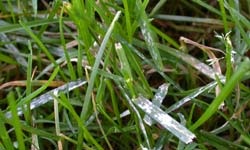
Occurs in late spring and fall. Areas of low light and poor air circulation favor the disease. Heavily shaded areas are particularly susceptible. Greyish-white powdery growth (looks like flour) appears on the blades. Starts as patches on the leaf blade and as the disease progresses it turns yellow and dies. Large areas infected with powdery mildew darken with age and sometimes transform into dark fruiting bodies. Infected plants are weakened, becoming more susceptible to other stresses.
Necrotic Ring Spot
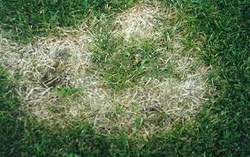
Occurs year round, especially in the spring but becomes more visible during warmer weather. It appears as perfectly shaped rings of yellowed-out grass with healthy grass growing inside the ring. The disease can occur from year to year depending on environmental and cultural conditions. Necrotic Ring Spot is a spore disease that is more common on sodded lawns but may also be found on seeded lawns in both sun and shade. The spores are spread by wind, air, water, animals and humans.
Leaf Spot or Melting Out
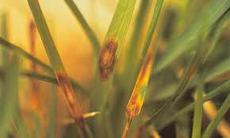
Occurs spring through summer during warm humid weather. Leaf spots are small dark purple to black spots on leaf blades. As the spots get larger the center turns a tan colour. As the temperature increases (above 28 C) the entire blade can appear dry and straw coloured. Leaf spots occur most often in lawns that are mowed too short.
Fusarium Patch
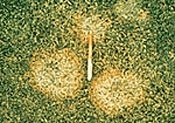
Occurs in cool wet weather in the early spring and fall. The infected lower leaves first show small reddish-brown spots. These spots will grow up to 10" in diameter. White to pink mycelium may be seen on the outer area of the patch with the center area turning from white to brown as the grass dies. Fusarium patch infection in the fall may persist throughout the winter and may increase the risk of Pink Snow Mold in the spring.
Dollar Spot
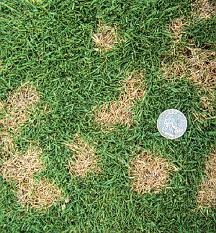
Occurs in summer, during warm weather. Round tan colored spots ranging from the size of a quarter to a silver dollar appear on the lawn. Spots appear sunken compared to the rest of your lawn. Yellow to light green lesions may appear and in the morning the spots appear grayish-white.
Anthracnose
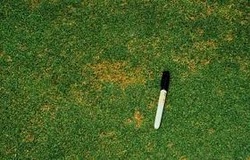
Occurs particularly in spring through late summer, in heavy traffic and poorly drained areas. There will be irregularly shaped patches of yellowish-bronze areas ranging from 2" to several feet. Leaf lesions usually appear as elongated reddish-brown spots on leaves which may encompass the entire grass blade. Black fruiting bodies with tiny spines may also appear on foliage.
